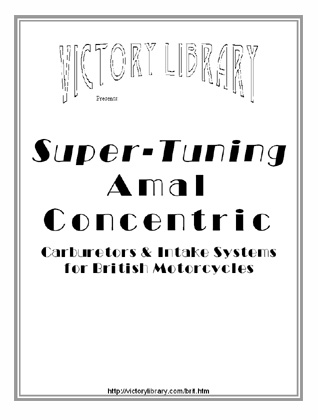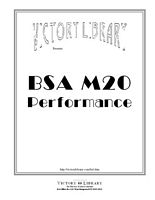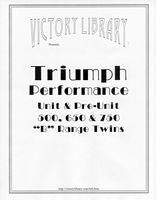|
|
 |
Background & History
The 1st use of the unit transmission usually referred to generically as the “A65” is in 1962. These machines (“A” Series 500, 650 & 750 cc twins) were originally offered with different internal transmission ratio gear-sets to best equip the machines for different purposes such as normal road and moderate performance use, road race,
and trials, sidecar and military & police, as shown below. Most of these parts are still available, and can be completely or partially retro-fit into transmission cases. The exact gear tooth counts and ratios used in these gear-sets have varied slightly over time, and complete interchange may not be possible.
My purpose is to supply information about what choices are available based on combinations of factory parts, explain some of the differences between the various ratios, describe in a general way what needs to be done for a selection, and warn you of potential difficulties. I will limit my comments to methods that have either already been
used successfully, or that I believe are sound concepts that are worthy of your time and effort.
Ratio Calculations
The BSA 4 speed transmission's intermediate gears (1st through 3rd) are the result of power transmission through two pairs of mating gears, one of which is the mainshaft high gear being turned by the layshaft (countershaft) high gear. The gear ratio is determined by taking the product of multiplying the two pair's tooth count ratios together: the high gear ratio times the ratio of the individual gear pair selected (1st, 2nd or 3rd).
The high gear ratio is the ratio of the tooth counts of the high gear pair for the transmission type selected (see “High Gear Pair” in Column 4 below).
For example, the std. transmission (the most common model) has 23 teeth on the mainshaft high gear and 17 teeth on the layshaft gear, so the high gear multiplier (Column 5) will be 1.352941 for this transmission.
The 2nd number is the ratio of the tooth counts of the pair of gears (mainshaft & layshaft) for that ratio: 1st, 2nd or 3rd.
The std. transmission has 26
teeth on the mainshaft 1st gear and 14 teeth on the layshaft 1st gear, so
the gear ratio for the 1st gear pair (Column 8) is 1.8571 for 1st gear in
the std. transmission. To get the actual effective ratio of 1st gear,
multiply those two numbers together: |
High Gear
Multiplier | |
× | |
1st Pair Ratio | |
= | |
1st Gear Ratio |
1.352941 | |
× | |
1.8571 | |
= | |
2.5125:1 |
|
In 4th gear the mainshaft high gear is locked to the mainshaft, so the ratio is 1:1. No power is transmitted through the intermediate gears. Although they still turn, they're only idling.
This Table shows some common transmissions, their internal gear-sets, and how the individual ratios are generated.
For transmissions based on the Std (standard) high-gear pair, the high gear tooth counts are: 23 for the mainshaft gear and 17 for the layshaft gear, so the 1st number is always 1.352941 for transmission gear-sets based on the “std.” high gear pair.
The overall governing component for all ratio selection is the high gear pair, which determines the range of ratio spread between 1st gear and 4th gear.
|
For BSA 500, 650 & 750 twins the original standard 4-speed transmission ratios are good compromises for mixed street and moderate performance use, and are“staged” or“progressive” in that the engine speed loss on shifting from 1st to 2nd is higher than the loss on shifting from 2nd to 3rd, etc.
The purpose is to keep the engine in its torque range at higher vehicle speed, where wind resistance requires more power for acceleration. Wider gaps between ratios will allow a “stronger” (higher numerically, e.g. 2.60:1 instead of 2.20:1) 1st gear for better manners in traffic, but increase the RPM lost on shifting. Narrowing the gaps will increase acceleration at speed, and potentially improve top speed under certain conditions, but acceleration from stopped and operation in traffic will suffer.
The 1st gear ratio for the Std. (late) 4-speed transmissions is 2.51:1, and 4th is always 1.00:1. The ratios of 2nd and 3rd are placed in between these two, and are discretionary to best serve the weight, intended use, speed, state of engine tune etc. of the motorcycle.
“Range” is the torque multiplication difference between 1st and 4th gears; wider-ratio gear-sets have more, typically between 2.8 and 3.2. This is the single most important determinant of low-speed acceleration.
“Progression” is the next factor. This is the
reduction or decay in the percentage drop in engine speed in the next gear (e.g. after shifting from 1st to 2nd). Most transmissions have some degree of progression in that the RPM drop
on the 1-2 shift is larger than the RPM drop on the 2-3 shift, which is in turn larger than the RPM drop on the 3-4 shift. The progression may not be linear (continuously reduced) or done in proportionate stages for various reasons, including a special need for a gear to reach a
specific speed or RPM for passing, racing, etc. or simply economic necessity: the parts were available.
The two factors are not mutually exclusive, but each limits the number of options for the other. A wide range, which gives a strong torque multiplication in 1st gear for excellent manners in low-speed traffic (especially with a smaller motor, heavy chassis or side-car) mean that the progression percentages must all be high. The
amount of engine speed (and therefore power) that must be lost on each up-shift is higher than would be the case in a transmission with less range (but less power in 1st gear). A numerically low 1st gear (2.02, &c.) reduces available torque in 1st gear, but allows more choices
of progression.
There is no choice of ratios that gives the “best” performance at all speeds, nor is there a choice of primary drive ratio or rear pulley ratio that gives the “best”; performance at all speeds. It simply doesn’t exist, all ratios are compromises, and not necessarily better than the original ratios for most use.
The advantage to a close ratio gear-set lies in the fact that the RPM loss at very high speed is reduced, allowing extra power to accelerate above 100 mph. However, of necessity the torque multiplier in the lower gears is reduced by the same proportion, and performance at low speeds is much worse. Even for road racing, the closest possible ratio is not always the best choice since some races begin with a flying start (favoring close ratios, where 1st gear acceleration is less important) and some with a grid start (favoring slightly wider ratios with high progession, where 1st gear acceleration is very important).
To give a larger spread between the gears, a wider ratio high-gear set can be installed in the other gear sets to give non-factory combination. It multiplies the 1st 3 gears a bit for better acceleration, then drops the rpm on the 3-4 shift. This allows a“taller” (numerically smaller) primary, pulley and/or overall drive ratio for higher top speed, without reducing acceleration in the lower three gears. Notice that the RPM loss on the shift is exactly the same, except the 3-4 shift.
In general, engines with smaller displacement (500), very long duration cams, ported heads, large carburetors &c. don’t pull well from low rpm., and when the 3-4 shift will benefit more from close ratios in the upper gears, and even more so as the maximum speed at a specific course increases.
If the shift takes place at a speed where air resistance is high (70+ MPH), closer ratios are better; the factory “Std.” gear-set is at a disadvantage with its 12.6% RPM drop on the 3-4 shift: 7,500 RPM drops to 6,551.
The factory close-ratio gear-set loses only 9.7% on the 3-4 shift (7,500 RPM drops to 6,775), and the motor (rather than“falling off the earth”) is right in its torque curve and accelerates better.
If your engine has been specifically designed for a tuned RPM torque peak (or if that’s how the engine behaves), the transmission ratios must be chosen to insure that after each shift during a lap the engine speed recovers to a point above this peak at that specific track. From the negative viewpoint, tha ratios must be arranged to avoid dropping the engine into a &ldquohole” on an upshift, where power falls off disproportionately.
If the widest ratio change gives a 25% loss, the shift RPM is 7,000 RPM, and there&rsquos a torque increase at 5,000 RPM you’re safe: 7,000 - 25% = 5,250, the engine will be in this desirable range on acceleration.
If the widest ratio change is 30%, shift at 7,000, and torque at 5,500: 7,000 - 30% = 4,900, far below the power range and the acceleration (and perhaps the jetting) will be weak until you reach 5,500. You will definitely benefit from a closer gear set, or at least re-arranging the progression to reduce the 30% drop to a better number. Depnding on the bike and the track, adding to the drop in the previous gear pair (i.e., problem with the 2-3 shift: add some drop to the 1-2 not the 3-4) is the 1st choice but results will vary.
Individual tracks with combinations of maximum speed and corner speed will require different intermediate (2nd & 3rd) gears to allow downshifting for a specific gear to enter a turn, or to use only one gear during a turn to avoid traction loss. The key to analysis here is whether your favorite track has a spot where the engine is “flat” after shifting at an awkward moment in a turn, but better as it speeds up. Closing the ratio between these 2 gears will help, but of course it moves the greater RPM drop somewhere else. |
For transmissions based on this special fabricated wide ratio high-gear pair, the high gear tooth counts are: 24 for the mainshaft gear and 16 for the layshaft gear, so the 1st number is always 1.5000 for transmission gear-sets based on the Beezabill high gear pair. |
|














